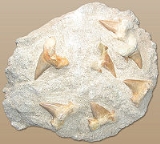
Otodus obliquus
Encyclopedia
Otodus obliquus is an extinct
mackerel shark which lived during the Paleocene
and Eocene
epochs, approximately about 60 to 37.5 million years ago.
teeth and fossilized vertebral centra. Like other elasmobranchs, the skeleton
of Otodus was composed of cartilage
and not bone
, resulting in relatively few preserved skeletal structures appearing within the fossil record. The teeth of this shark are large with triangular crown, smooth cutting edges, and visible cusps on the roots. Some Otodus teeth also show signs of evolving serrations.
s of Otodus indicate that it was a very large macro-predatory shark. The largest known teeth measure about 104 millimetres (4.1 in) in height. The vertebral centrum of this shark are over 12.7 cm (5 inch) wide. Scientists suggest that this shark commonly approached 9 meters (30 feet) in total length (TL).
s, large bony fish, and other sharks. It was among the top predators of its time.
in Maryland, USA, Ypres clay in Belgium, and western Kazakhstan
, which are morphologically very similar to Otodus teeth but with lightly serrated cusplets and a serrated cutting edge. These transitional fossils suggest a worldwide evolutionary event, and support the theory that Otodus eventually evolved in to Carcharocles aksuaticus and thus initiated the Carcharocles lineage.
Extinction
In biology and ecology, extinction is the end of an organism or of a group of organisms , normally a species. The moment of extinction is generally considered to be the death of the last individual of the species, although the capacity to breed and recover may have been lost before this point...
mackerel shark which lived during the Paleocene
Paleocene
The Paleocene or Palaeocene, the "early recent", is a geologic epoch that lasted from about . It is the first epoch of the Palaeogene Period in the modern Cenozoic Era...
and Eocene
Eocene
The Eocene Epoch, lasting from about 56 to 34 million years ago , is a major division of the geologic timescale and the second epoch of the Paleogene Period in the Cenozoic Era. The Eocene spans the time from the end of the Palaeocene Epoch to the beginning of the Oligocene Epoch. The start of the...
epochs, approximately about 60 to 37.5 million years ago.
Known physiology
This shark is known from the fossilFossil
Fossils are the preserved remains or traces of animals , plants, and other organisms from the remote past...
teeth and fossilized vertebral centra. Like other elasmobranchs, the skeleton
Skeleton
The skeleton is the body part that forms the supporting structure of an organism. There are two different skeletal types: the exoskeleton, which is the stable outer shell of an organism, and the endoskeleton, which forms the support structure inside the body.In a figurative sense, skeleton can...
of Otodus was composed of cartilage
Cartilage
Cartilage is a flexible connective tissue found in many areas in the bodies of humans and other animals, including the joints between bones, the rib cage, the ear, the nose, the elbow, the knee, the ankle, the bronchial tubes and the intervertebral discs...
and not bone
Bone
Bones are rigid organs that constitute part of the endoskeleton of vertebrates. They support, and protect the various organs of the body, produce red and white blood cells and store minerals. Bone tissue is a type of dense connective tissue...
, resulting in relatively few preserved skeletal structures appearing within the fossil record. The teeth of this shark are large with triangular crown, smooth cutting edges, and visible cusps on the roots. Some Otodus teeth also show signs of evolving serrations.
Size estimation
The fossilFossil
Fossils are the preserved remains or traces of animals , plants, and other organisms from the remote past...
s of Otodus indicate that it was a very large macro-predatory shark. The largest known teeth measure about 104 millimetres (4.1 in) in height. The vertebral centrum of this shark are over 12.7 cm (5 inch) wide. Scientists suggest that this shark commonly approached 9 meters (30 feet) in total length (TL).
Distribution
Otodus was a widespread species, as its remains have been excavated from Africa, Asia, Europe, and North America.Diet
O. obliquus likely preyed upon marine mammalMarine mammal
Marine mammals, which include seals, whales, dolphins, and walruses, form a diverse group of 128 species that rely on the ocean for their existence. They do not represent a distinct biological grouping, but rather are unified by their reliance on the marine environment for feeding. The level of...
s, large bony fish, and other sharks. It was among the top predators of its time.
Evolution
Scientists postulate that Otodus evolved into the genus Carcharocles, given substantial fossil evidence in the form of transitional teeth. Some teeth have been excavated from the sediments of the Potomac RiverPotomac River
The Potomac River flows into the Chesapeake Bay, located along the mid-Atlantic coast of the United States. The river is approximately long, with a drainage area of about 14,700 square miles...
in Maryland, USA, Ypres clay in Belgium, and western Kazakhstan
Kazakhstan
Kazakhstan , officially the Republic of Kazakhstan, is a transcontinental country in Central Asia and Eastern Europe. Ranked as the ninth largest country in the world, it is also the world's largest landlocked country; its territory of is greater than Western Europe...
, which are morphologically very similar to Otodus teeth but with lightly serrated cusplets and a serrated cutting edge. These transitional fossils suggest a worldwide evolutionary event, and support the theory that Otodus eventually evolved in to Carcharocles aksuaticus and thus initiated the Carcharocles lineage.

